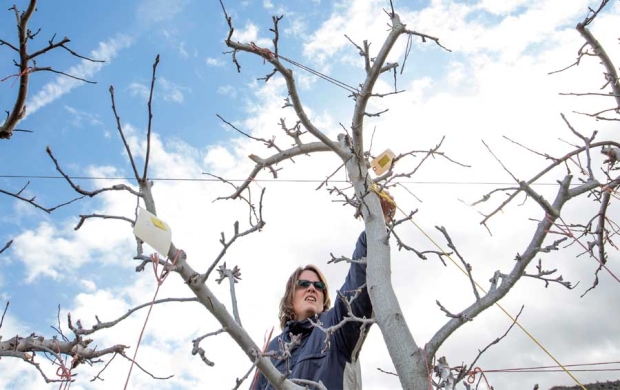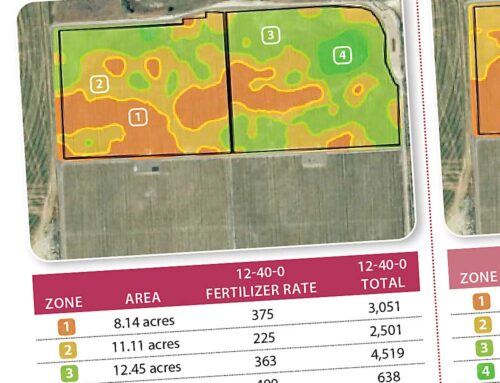
Tip #5 – Gwen Hoheisel, Washington State University, checks water sensitive paper that helps workers determine where an orchard sprayer’s nozzle is hitting the trees during a spray training in Naches, Wash., on March 15, 2016. (TJ Mullinax/Good Fruit Grower)
Recent complaints about pesticide spray drift from Washington orchards highlight the need for greater education about sprayer technology, from calibration and optimization to maintenance and monitoring.
A new class offered in partnership by the Washington State Department of Agriculture, Washington Department of Labor and Industries and Washington State University provides workers with information and tools to ensure pesticide sprayers are calibrated and configured to meet the needs of orchards that may vary in tree structure or canopy size, while also reducing drift.
Here are five key points from that workshop:
1 Empower and plan. Growers must empower their employees with the time, knowledge and tools to perform the steps necessary for a successful spray program — one that both meets crop needs and reduces spray drift.
Some of these steps, such as maintenance and calibration, will be performed annually, while others may only need to be done every two years. It really depends on the specific area a grower wants to monitor, but regardless, all growers need to make a commitment to ensure their workers are empowered to plan and prepare for the season and to carry out the steps as the season progresses.
2 Maintenance should be completed daily and annually. All of the parts of a sprayer need to be working properly to ensure proper calibration and optimization. Is your pressure gauge working correctly? Are your hoses worn?
What about electronics that might be on your sprayer? All need to be working correctly to ensure the spray program meets its goals but doesn’t overshoot the orchard.
3 Sprayer calibration should be performed at least annually to ensure that growers and workers know the proper amount of spray is being applied. There are many methods that people use for calibration, and each has its own pros and cons.
This class teaches methods that allow workers to evaluate individual nozzle output so that they know whether each nozzle is good or bad.
4 Optimization is about getting every drop to the crop. There are two parts to optimization. The first part is to direct all the spray into the canopy, by adjusting nozzle direction or turning nozzles on or off.
The second part involves matching the air volume with the canopy density.
Wherever the air flows, the spray will follow, and growers want the spray to stay in the row.
There are three methods to reduce air volume: gear up or throttle down the sprayer, limit the amount of air coming into the fan by covering the cage fan with plywood doughnuts or cloth shrouds, or change the fan setting from high to low.
Eventually, there will be commercial technologies that will allow for the air volume to be adjusted automatically. In the meantime, growers should ensure these steps are taken in the field to optimize spray output.
5 Monitoring. Workers need to be able to make these adjustments and determine whether the spray went where it was supposed to go. Did it stay in the canopy? Did it drift?
Growers should put out water-sensitive paper to determine where spray is going. Growers often ask how long their ceramic nozzles will last, but that’s a question that is dependent on their water quality and spray programs.
However, they could monitor these nozzles in the calibration and be able to come up with management rules.
Workers can’t manage spray unless they monitor it, which means they need to be empowered to do so. Growers have to empower people to monitor so they can make adjustments and ensure these adjustments work. •
– by Gwen Hoheisel, a regional extension specialist for Washington State University in Prosser, Washington.
ONLINE
Gwen Hoheisel explains six steps to calibrate and optimize airblast sprayers: bit.ly/sprayer_calibration






Leave A Comment